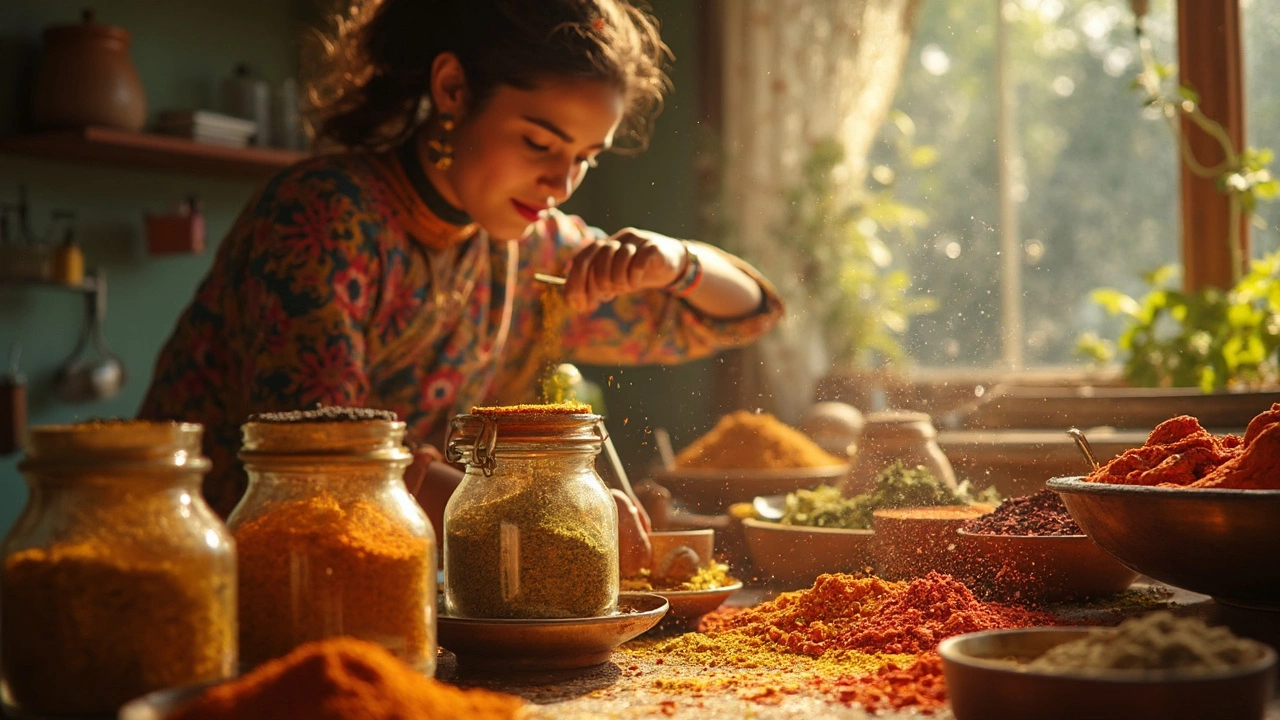If you've ever craved the smoky, vibrant taste of tandoori chicken but found yourself without tandoori masala, you're not alone. The heart of this dish lies in its spice blend, which packs a powerful punch. But don't worry, there are creative ways to replicate it using common spices already in your pantry.
Tandoori masala is essentially a mix of various spices that gives that classic Indian flavor. The usual suspects include cumin, coriander, paprika, turmeric, and sometimes even a bit of cinnamon for a sweet hint. Knowing these can help you improvise when the packets run dry.
- Understanding Tandoori Masala
- Key Ingredients of Tandoori Masala
- Quick Substitution Ideas
- DIY Tandoori Masala Blend
- Adjusting Flavors to Taste
- Tips for Cooking with Substitutes
Understanding Tandoori Masala
Tandoori masala is the cornerstone of many iconic Indian dishes, especially tandoori chicken. This spicy, aromatic blend is what gives grilled meats their distinctive flavor and appearance. But what's really inside this magical mixture?
Typically, a standard tandoori masala blend contains a mix of core ingredients that define its signature taste. These include cumin, which adds earthiness, coriander for a hint of citrus, and cayenne pepper or paprika to bring the heat and that fiery red color. Turmeric is often included for its earthy flavor and vibrant hue. Some blends even contain a touch of cinnamon or nutmeg for a slight sweetness.
Origins and History
The use of tandoori masala dates back centuries in Indian cooking. Originally from the Punjab region, this blend was crafted to enhance meats cooked in traditional clay ovens, or tandoors. These ovens reach extremely high temperatures, which helps lock in the flavors of the masala while keeping the meat juicy and tender.
Commercial vs. Homemade
Today, you can find pre-made tandoori masala mixes in most grocery stores. These provide convenience but can vary in taste and quality. Some may have added salt or preservatives, so it's always wise to check the labels. If you want full control over the flavor, making your own blend is an excellent option.
Here’s a quick comparison between commercial and homemade blends:
| Feature | Commercial | Homemade |
|---|---|---|
| Flavor Control | Limited | High |
| Preservatives | Possible | None |
| Customization | Limited | High |
Understanding these differences helps in making an informed choice. Whether you go for store-bought or DIY, knowing what's in your tandoori masala lets you adjust it to your liking, ensuring a perfect dish every time.
Key Ingredients of Tandoori Masala
While the exact blend can vary depending on the cook, some spices are non-negotiable when making tandoori masala. These spices together create the unique, bold flavor that makes your tandoori chicken so irresistible.
Cumin and Coriander
At the forefront of the mix, you'll often find cumin and coriander. Cumin gives that earthy warmth, while coriander adds a hint of citrus, making them a perfect pair.
Paprika
Next up, paprika. This one not only adds a deep red color to the dish but also provides a mild heat. It's much less spicy than chili powder, but it brings just enough warmth to the table.
Turmeric
No Indian spice blend is complete without turmeric. It lends that characteristic golden hue and a slightly bitter, peppery flavor. Plus, it's known for its anti-inflammatory properties, making it both tasty and beneficial!
Garam Masala
Some folks like to add a dash of garam masala. This component is a mix in itself and can include spices like cloves, cinnamon, and nutmeg. It rounds out the flavor profile with a touch of sweetness and warmth.
Optional Additions
- Cayenne Pepper: Use for extra heat.
- Ginger Powder: Brings in a zesty note.
- Cinnamon: Adds a sweet undertone.
These components combine to create that signature, mouth-watering tandoori flavor. Whether you're making a whole batch or just substituting, knowing these basics allows you to play around until you hit that perfect spice combination!
Quick Substitution Ideas
Ran out of tandoori masala? No sweat! Here’s how you can whip up some quick alternatives without making a trip to the store. It’s easier than you think and just might become your new secret weapon in the kitchen.
Use Basic Spice Combos
Start by reaching for some core spices that are likely sitting in your spice rack. Mix equal parts of cumin, coriander, and paprika. These spices form the heart of the tandoori masala, so it’s a solid base to start with. Want some heat? Throw in a bit of cayenne. Like it smoky? Smoked paprika does wonders.
Shortcut with Curry Powder
If you've got curry powder lying around, this can serve as a quick fix too. It’s not exactly the same, but with a splash of lemon juice and yogurt, it gives that flavorful profile reminiscent of tandoori.
DIY Tandoori Blend
Ready for a slightly more involved method? Create a quick DIY blend. Mix together:
- 2 teaspoons cumin
- 2 teaspoons coriander
- 1 teaspoon paprika
- 1 teaspoon turmeric
- 1 teaspoon cayenne pepper
- 1 tablespoon garlic powder
- 1 tablespoon onion powder
Combine these with a bit of salt and pepper to taste. This mixture will get you pretty close to the real deal.
Add Fresh Elements
Sometimes, fresh ingredients can elevate your substitute blends. Add minced ginger or crushed garlic directly to the marinade or while cooking, alongside your spice mix.
A Little Experimentation
Last but not least, don’t be afraid to tweak the quantities to suit your taste buds. Tandoori dishes are all about personalized taste, so what works for one might not for another. Trust your instincts and enjoy the process.
With these easy substitutions, you’re all set to keep your tandoori chicken game strong and flavorful!

DIY Tandoori Masala Blend
Creating your own tandoori masala at home is not only simple but lets you control the flavors to your liking. You don't need a laundry list of spices, just a few key ones you probably already have in your spice rack.
Essential Ingredients
Here's a straightforward recipe to get you started:
- Coriander: 2 tablespoons
- Cumin: 1 tablespoon
- Turmeric: 1 teaspoon
- Paprika or Kashmiri Red Chili Powder: 1 tablespoon
- Garam Masala: 1 teaspoon
- Ginger Powder: 1/2 teaspoon
- Garlic Powder: 1/2 teaspoon
- Cayenne Pepper (optional): 1/2 teaspoon for extra heat
Instructions
- Measure out each spice carefully. Consistency is key to getting that authentic tandoori chicken flavor.
- Mix thoroughly in a small bowl, ensuring no lumps.
- For a finer texture, you can grind the spices together in a mortar and pestle or a spice grinder.
- Store the blend in an airtight container and keep it in a cool, dark place to preserve its potency. It'll be ready whenever you're eager to whip up a spicy dish.
This blend isn't just for chicken either; try it with vegetables or tofu for a vegetarian twist. Dare to experiment, and you'll likely discover some new favorites.
Adjusting Flavors to Taste
Once you've whipped up your own tandoori masala substitute, you might find that the taste isn't exactly like your go-to blend. That's totally normal. Spice blends can vary widely between brands, and personal preference plays a huge part too.
Same Base, Different Ratios
Tandoori masala can be adjusted based on what flavors you want to shine through. If you prefer a bit more heat, up the cayenne or add more paprika. Love that savory note? Consider adding extra cumin. It's all about balancing the flavors to your liking.
Boosting Flavor Profiles
Freshness matters when it comes to spices. If your homemade blend feels a bit flat, your spices might have lost some of their punch. Try using freshly ground spices instead. This simple switch can make a world of a difference.
Experimentation and Adjustment Tips
- Start with small adjustments. It's easier to add more than to tone it down.
- Test your blend on a smaller dish first before using it for your main meal.
- Consider adding a touch of lemon juice or vinegar to brighten up the flavors.
Extra Flavor Boosts
For an extra twist, think beyond the spices. Consider the method of cooking—grilling over charcoal, for example, can lend a smoky flavor reminiscent of a traditional tandoori oven. Or add freshly chopped herbs like cilantro before serving for a fresh touch.
Tips for Cooking with Substitutes
Switching up your tandoori masala blend when making tandoori chicken can be an exciting adventure. Here are some practical tips to nail that flavor.
Balancing the Spice Levels
When using a substitute for tandoori masala, always start small. It's easier to add more seasoning later than to tone down a dish that's too spicy.
Play with Proportions
Feel free to tweak the ratios. If you like your chicken spicier, increase the amount of cayenne or paprika. For a milder taste, emphasize cumin or coriander instead.
Marination Magic
Let your chicken soak up all the good flavors. A few hours of marination can make a big difference, but overnight is even better if you have the time.
Use Yogurt Wisely
If your substitute blend is on the spicier side, combining it with yogurt can mellow the heat while enhancing the dish's tangy essence. Don't skip this step unless you're dairy-free.
Pay Attention to Cooking Techniques
Cooking on high heat helps achieve that charred, smoky flavor typical of tandoori chicken. If using an oven, broil for a few minutes at the end for that perfect finish.
Experiment and Taste
The fun part about experimenting is that you can really tailor the taste to what you and your family love. After marinating, fry a small piece to taste before committing to cooking the whole batch.
Texture Considerations
- Find a balance between whole and ground spices to create a blend that packs texture but isn't gritty.
- Consider using fresh ginger and garlic to boost the dish's aroma along with your spice mix.
By following these tips, you'll be on your way to making delicious tandoori chicken even when you’re out of the traditional tandoori masala.
